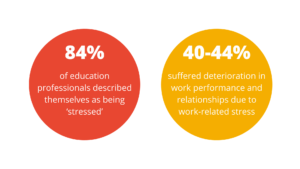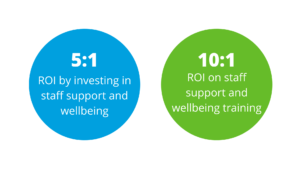Investing in Staff Wellbeing – Can you afford not to?
By Karen Amos
The Education Staff Wellbeing Charter is launched this autumn. Whilst few would argue this isn’t needed in the sector, the practicalities of publicly signing up and implementing such a measure can have the paradoxical effect of actually increasing the stress of those charged with the task.
This is a fantastic opportunity to commit to positive steps to improve the working lives of all working in education. The danger is however, that it becomes another ‘bolt-on’ to the day-to-day work. The fact is that for any actions to be truly meaningful, the principles of this charter need to form the bedrock of your setting and define your wellbeing culture.
So what is culture?
Culture can be defined as the guiding beliefs and values evident in the way a school operates. ¹ Put simply, culture is seen in our behaviour, or ‘the way we do things around here’. ²
This is more than just having some pretty graphics of your values on the wall. This is about observable, tangible behaviour. For good or bad, your setting’s culture is determined by how people consistently behave.
In practical terms, this means we have to do much more than just bring cake into the staff room. This is a nice gesture, not a wellbeing support intervention. If you have a team who are stressed out and on the edge, you’re quite likely to make matters worse and risk being told where to shove your cake, if there are no other support mechanisms in place.
The costs of not implementing a wellbeing culture:
Of course there are clear ethical issues why staff wellbeing should be a priority. But there is also a financial and business case for improving wellbeing too.
The latest Education Support Teacher Wellbeing Index survey showed some shocking statistics. If they don’t constitute a crisis in the education sector right now, there should certainly be some very loud alarm bells ringing.
Deliotte’s research highlights the financial impact of the problem. The cost to the Education Sector in 2020 in the UK is £1.1 – 1.5 billion per year. That £1.1-1.5 thousand per education staff per year. Let’s put the ethics aside for a moment and just ask yourself what your setting could do with that money instead? What difference would this make to the outcomes of the children or communities you work in?
There are obvious costs such as sickness absence, but also other less obvious, but equally impactful issues, such as lack of productivity and presenteeism from burnt out or disillusioned staff. And what about the time costs of counselling unproductive, unhappy or unwell staff teams. How much time do you and your team spend each month on these activities, when someone reaches crisis point?
Viewed this way, implementing a culture where staff wellbeing is front and centre should be seen as an investment, not a drain on resources. In fact, Deloitte4 found a clear Return on Investment from implementing wellbeing support in the workplace, with a 10:1 ROI on training.
Also at a time where many schools are struggling to recruit the right calibre of candidates, wouldn’t it be a benefit for your setting to be seen as a ‘go to’ employer?
How to implement a wellbeing culture in a busy setting:
Whilst there is some element of ‘setting up’, a successful wellbeing culture shouldn’t add to your workload and does not have to mean a major financial investment. Here are a few suggestions to get you started:
- Embed wellbeing in training and development – The Education Staff Wellbeing Charter states there is no expectation for managers to provide professional wellbeing support for which they have no professional training, so…
- Consider outsourcing – See this as an investment. How much do you currently spend in staff cover or lost productivity? Consider the business case for bringing in the experts, whether that’s training, resources, or an Employee Assistance Programme.
- Build staff engagement – start with building great conversations in your setting. Not just between managers and their teams, but also between peers. Recent surveys show that 57% of education staff were not confident in sharing unmanageable stress/mental health issues at work. 3 Building trust and understanding are key to positive staff engagement.
Building trust and understanding are key to positive staff engagement – which leads us to…
- Develop a supportive leadership culture – Where people feel supported, not criticised. Using a coaching approach is a fantastic and practically cost-free strategy. This doesn’t mean lengthy 1-to-1 sessions with people, but simply that we have meaningful conversations where leaders are curious and solution-focused.
- Draw up a Wellbeing Strategy – this will support everyone to maintain realistic expectations and standards, including around workload. This doesn’t need to be a huge document. No-one needs another ‘War and Peace’ that never sees the light of day. Just one page with your aims for the coming year and a couple of concrete actions constitute a strategy. This could be as simple as having a realistic workload policy and an effective return to work interview format.
- Develop robust HR procedures and get the right support – This way you can ensure you ‘do the right thing’ by your staff, but also ensure any responses and approaches are proportionate and aligned with your setting’s wider strategy and outcomes. This isn’t about giving in to unreasonable demands or lowering standards, but setting clear expectations and knowing what support you will and won’t give.
The ethical argument in favour of building a wellbeing culture should be obvious, but if implemented, everyone wins. Everyone. The children, the staff, the setting, the community… everyone. What are your next steps?
- Fullan, M., (2007) The new meaning of educational change, Routledge, New York.
- Hawkins, P., (2021) Creating a coaching culture: Developing a coaching strategy for your organisation, Open University Press, UK.
- Education Support Teacher Wellbeing Index 2020
- Deloitte – Mental Health and Employers – Refreshing the case for investment – 2020
If you would like to find out more about how you and your teams can improve their time management and productivity, whilst minimising stress and overwhelm, check out our new Positive and Productive online programme.
For schools
For Business and VCSE organisations
For an informal, no-obligation chat about how we can help you, call us on 07714 855757, or email info@bright-bird.co.uk.
 Karen Amos is an executive coach and founder of BrightBird Coaching & Training. She supports business owners and managers who are feeling the pressure, to get the best out of themselves and their teams. She brings a practical, down-to-earth approach to improving working lives through better leadership, communication and working relationships.
Karen Amos is an executive coach and founder of BrightBird Coaching & Training. She supports business owners and managers who are feeling the pressure, to get the best out of themselves and their teams. She brings a practical, down-to-earth approach to improving working lives through better leadership, communication and working relationships.
You May Also Like
Tips to Make Difficult Conversations Easier
September 11, 2024
A coaching approach is a superpower for any manager. Here are a few tips to…
Tips to Turn a Coaching Approach into your Leadership Superpower
April 23, 2024
A coaching approach is a superpower for any manager. Here are a few tips to…
Why it’s not normal to be happy – and what you should do instead…
March 5, 2024
Many of us feel we're failing at happiness. Here are some coaching questions…
Two words that say you have an accountability and responsibility problem – and how to solve it…
March 5, 2024
There are two words I hear so often from managers at all levels and when I do,…






